Photos with this report (click to enlarge) | |||
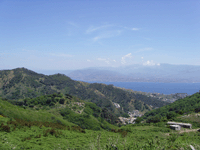 Monti Peloritani hills |
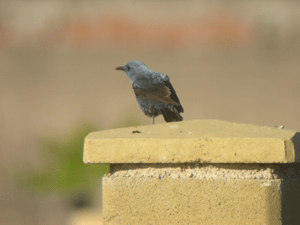 Blue Rock Thrush |
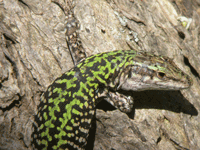 Italian Wall Lizard |
|
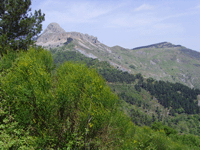 Monti Peloritani range |
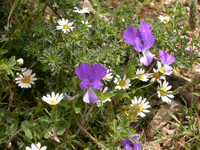 Flora @ Sant Dinnammare |
||
Introduction
Sicily is renowned for its raptor passage in spring when birds leaving Libya and particularly Cap Bon, Tunisia on their northward migration across the Mediterranean head out towards this island, the largest in the Mediterranean just a few hours away. Cap Bon is just 159km from the far south west corner of Sicily so birds arriving across the Mediterranean at this end then make their way across the island mostly using the hills along the north coast before reaching the Monti Peloritani range in the north east. This stretch of the journey across Sicily is another 280km but once they reach the Straits of Messina, it is just a mere 3km hop into mainland Italy and safe passage to their breeding grounds in Europe & Asia.
My wife Gerda and I had never visited Sicily before but always seeking out new places to visit and fuelled by the prospect of witnessing one of Europe’s most exciting migration hotspots as described by Corso (2001) we decided to give it a try in 2008. Unfortunately our homework was hampered by a real lack of information on the place and other than the excellent article by Corso (http://www.surfbirds.com/mb/Features/messina/messina-0302.html) in September 2004 which gives a very thorough treatment of the area, I only managed to find one trip report on the internet concerning the island: for SE Sicily January 2001 (also on surfbirds). Concerned that with such a large island we might end up staying somewhere off the main raptor migration highway altogether, I emailed Andrea Corso direct for advice. I am indebted for his prompt reply and help in us reaching a decision where to stay as first-timers to the island. With a limited budget we decided on a chalet at Il Peloritano Camping on the north coast just a few km away from Messina. In view of the lack of trip reports available, I offer this report of our stay in the hope it will help others planning a visit to Sicily.
The raptors
As mentioned, Sicily is famous for its raptor migration in particular and with 40 species being recorded there since 1984 (Corso 2004) it surely does rate as one of the top sites in the Western Palearctic for this group of birds. The numbers of individuals are impressive too and in Corso 2001, the year 2000 produced the following totals for the spring passage across the Straits of Messina: Honey Buzzard (27,297), Black Kite (1,008), Red Kite (6), Egyptian Vulture (9), Short-toed Eagle (2), Marsh Harrier (3,074), Hen Harrier (3), Pallid Harrier (3), Montagu’s Harrier (866), Goshawk (2), Sparrowhawk (11), Common Buzzard (67), ‘Steppe Buzzard’ (36), Long-legged Buzzard (11), Lesser Spotted Eagle (4), Imperial Eagle (1), Golden Eagle (4), Booted Eagle (16), Bonelli’s Eagle (2), Osprey (19), Lesser Kestrel (24), Kestrel (464), Red-footed Falcon (1012), Merlin (3), Hobby (207), Eleonora’s Falcon (28), Lanner Falcon (1), Saker Falcon (2), Peregrine (25).
Although Andrea advised the end of April or first week of May would have been preferable over our choice, work commitments meant we were unable to get away earlier, but armed with two weeks leave, a Leica scope and a base at our campsite near Messina we arrived on 8th May in eager anticipation of a major birding break. I should add here that Gerda is by no means as keen as yours truly on the birding front so our holidays are always restricted to the hours dawn to dusk in order to accommodate other activities. This in no way however, should detract from our main aim, to see as much as we can. It therefore came as some surprise and disappointment that our list didn’t quite match up to the above. It transpired that, at least during our stay in Sicily, it is an ‘all or nothing scenario’. The wind direction is everything…
It turned out that prior to our arrival on 8th the wind had been in the north (NW is best apparently) and the period 25th April-8th May produced “thousands of raptors”. I didn’t find this out until we met a couple of volunteer counters a week later but because wind direction seems to be so critical for raptor passage here it is worth expanding on this a little. Given the above figures from Corso (2001), it is tempting to assume there will be raptors passing all the time. Not true! After our first week of constant looking and driving around I hadn’t even seen another birder and I began to wonder if we had flown onto the wrong island! Other than a few Kestrels and Honey Buzzards, we had seen little of the raptor migration we had expected. Only two Red-foots and no Montagu’s at all. It transpired our arrival had coincided with a change in wind direction from NW to SE and it wasn’t until ‘Day 7’ when the wind suddenly went back to NW with rain that Honey Buzzards started arriving en masse: 673 over our campsite in just the morning! The next day the wind reverted to SE and stayed that way for the rest of our holiday – disastrous!
We did however, notice there appeared to be two movements of raptors during the day on many days with a peak in the morning and then another from 3-4pm. We thought this may have been due to those birds arriving from Africa late the day before staying overnight on Sicily and then moving on the following morning (on some of the warm mornings I had Honey Buzzards moving through from 0730hrs). By lunchtime things appeared to slacken off but then another peak mid-afternoon would sometimes be apparent as presumably the birds which had left Cap Bon the same morning started to arrive. I mentioned this to Anna Giordano whom we met on our penultimate day. Anna organizes the annual count of raptors (see below) and confirmed this is probably true some days but when movement is in full swing, the birds migrate through all day.
Main raptor watch points
For the best raptor watching, the birding guides make much of places like Monte Ciccia above Messina. We spent three days trying to find it! Forget that place. It is on no road sign and all the locals we spoke to either didn’t know of it, or said we couldn’t drive there. At this point I should add the caveat that we don’t speak any Sicilian/Italian (but our map didn’t help either) and we seldom met anyone on the island who spoke English so were at a disadvantage on this front. I’m sure the books are correct however, when they say go to Portella Castanea ‘especially when the winds come from the north’ or Castanea/Santa Rosalia ‘if the winds are in the south’ but there is little advice on where to go when the winds are from other directions; we spent two weeks under a south-easterly airstream and we didn’t know where to go!
Because we spent so much time trying to find a good vantage point, bewildered by the lack of raptors during the first week of our stay, I will detail more precisely where one should go as a general rule to establish where in the Monti Peloritani hills to head for during any given wind direction. My advice would be to head to the crossroads at colle S. Rizzo (altitude 460m) in the Monti Peloritani about midway between the north and south coasts. From our campsite at Il Peloritano, take the SS113 coast road west for 2km and join the main road to Messina (not the toll road) continuing south inland for 9km to the colle S. Rizzo crossroads at the top of the hill (alternatively, coming from Messina take the SS113 Via Palermo road north to the crossroads). Here you can continue south to Messina or west to Sant. Dinnammare. Instead turn left towards Castanea passing the restaurant Don Minico on your right. After only 1km you will pass another restaurant/pizzeria on your right, the Ristorante la Pineta and just 2-300m beyond this is an outstanding viewpoint of both coasts signed Instituto M.AUSILIATRICE Centro di Spiritualiita, colle S.Rizzo (known locally as the monache, Monti Telegrapho apparently). Depending on the wind direction you should either look north from here (there is a terrace next to the road with outstanding views over the hills) or south (dirt track ditto), but whatever the wind look up! We met our only Sicilian birders here and they confirmed this was a pretty good vantage place to look from. They also confirmed the last few days had been pretty useless on the raptor front because of the SE winds but they had had some success down on the Straits at the lighthouse, Torre Faro.
Logistics
We flew from Gatwick to Catania with Air Malta for a return price of £15 each! But add £117 in taxes. Car hire with Avis was £322 including additional driver & insurances but with our Tesco Club points it only cost us £78 for the two weeks (note this offer has now expired so it would pay to shop around). Staying at Il Peloritano Camping was £342 for a chalet with everything we needed (says sleeping for 4 but only one double bed, others would be on the divan). Eating out was expensive as the pound is weak @ Euro1.19 (instead of 1.45 a year ago) but we had self-catering at the campsite so bought food locally (in Villafranca supermarkets, local stores and roadside stalls) and if food was costly, beer and wine was cheap! Petrol was also expensive @ £1.25/litre but as we didn’t plan on straying far this wasn’t a problem. Of course if you are hoping to include some wetland areas or some of the famous historical sites then this would be an issue with such a large island. Our round trip to the flanks of Mt Etna for example was 186km and that didn’t include the summit (it was in cloud both days we went so we didn’t bother). However, to visit Mt Etna proper you will need to budget an extra £19.32 just to take the cable car to 2,500m from where a four hour round-walk will take you to the ‘authorised crater area’. You then need to join a guided tour along the rim as Mt Etna is of course highly active so you are not allowed to do this on your own. A mini eruption actually occurred whilst we were there with lava flowing from the crater but we were oblivious to this.
Driving
I’ve written a few trip reports before and don’t usually have this as a heading. In India or Lebanon for example you expect it to be “challenging”. However, I have to say driving in Sicily is pretty bad. The big towns are worst and certainly not for the faint-hearted and many drivers drive with their wing mirrors in to help squeeze through the traffic. Most cars you see are scratched and the fact that Avis gave us a new one with only 4km on the clock meant we usually parked on the outskirts of such places and walked in! Excess insurance either through your own insurers or the car hire company is an absolute must in Sicily. The roads outside of town are quiet, the toll and mountain roads especially so but be prepared to be overtaken either side on the former and to meet oncoming vehicles on your side of the road on bends in the latter. ‘Fortunately’, you will be made aware of other drivers at any time by the liberal use of the horn.
Other places visited
Because Sicily is such a large island it wasn’t really practical for us to travel far. Given the cost of fuel and the trauma of driving as mentioned above, we only really explored the north east. It would have been good to have seen more of the island and in retrospect, had I known how quiet the raptor migration was going to be, we might have traveled further afield during the south-easters, or even stayed in another part of the island for the second week when the passage period is slowing.
Future visits and help with counting raptors
There is no doubt we were just unlucky with the weather. Anna Giordano told us the weather (SE wind) and its duration had been unusual for the time of year and had the winds been in the NW this would be a very different trip report. Anna works for WWF and is a volunteer for the Associazione Mediterranea per la Natura (Mediterranean Association for Nature) which runs the international camp for the counting of raptors across the Straits each spring and this year they have celebrated 25 years of counting. The camp provides food and accommodation for volunteers from overseas for a daily fee of 15 euros and they will even arrange local transport eg. daily visits to the count sites. Because Gerda didn’t want to spend our holiday “just looking for raptors” we arranged everything separately but if I was going alone I wouldn’t have hesitated in booking with Anna. Sicily has suffered of course from shooting in the past and I wouldn’t have even considered going ten years ago. Thanks to Anna and her team, all that has changed. The shooting hides (there are 17 around Monte Ciccia alone) are now silent and we didn’t hear a single shot in the entire fortnight. I would urge anyone reading this to seriously consider staying as a volunteer at the camp to help with this important work. Alternatively Anna suggests phoning in each day for advice on where to go to look for raptors. As they counted no fewer than 38,367 raptors and storks last year this seems a sensible suggestion (note, however, “a total absence of SE winds for 25 days” might have had something to do with this)! For more information see http://www.migrazione.it/
Systematic list: 103 species recorded.
(NB: Numbers in parenthesis are approximate number of individuals seen and although in many cases merely an estimate, at least I hope provide some idea of the relative abundance of birds to be seen in this part of Sicily during a fortnight’s birding)
Cory’s Shearwater (?). Up to 10 a day off Il Peloritano campsite beach, often close inshore.
Levantine Shearwater (?). Less frequently seen off Il Peloritano campsite beach than above species and always more distant but usually in flocks. Max 18/day.
Great Cormorant (1). Only one seen – at the lagoons at Ganzirri on 11th.
Little Egret (5). Only seen at Ganzirri lagoons. Max five there on 20th.
Cattle Egret (14). Only seen in the Catania area with max of 13 at the airport counted from the plane as we headed home on 22nd.
Grey Heron (2). Single birds at Il Peloritano campsite area and Ganzirri.
Squacco Heron (1). One flew east up the coast off Il Peloritano campsite beach on 14th.
Black Stork (1). One flew east over the hills south of Il Peloritano campsite on 14th.
Mallard (4). Female with three ducklings on river at Fiumefreddo di Sicilia on 15th.
Osprey (1). Single south over Il Peloritano campsite on 19th.
Honey Buzzard (917). Recorded on nine dates with maxima 59 9th, 33 12th, 46 13th and 731 14th.
Black Kite (8). Only recorded six dates with never more than 2/day.
Marsh Harrier (35). Recorded most days, all immatures/females.
Sparrowhawk (1). No migrants but a displaying male in the hills below monache on 20th.
Common Buzzard (27). Mostly local breeding birds seen, few migrants.
Booted Eagle (1). Single dark morph low over monache on 14th flew east.
Kestrel (21). Daily. Mostly resident birds.
Red-footed Falcon (7). Not as many as I had hoped! Four together over our campsite on 19th were the best.
Hobby (3). Three single migrants east on different days.
Peregrine (3). One along the coast near Taormina the day we arrived and a pair at monache on 20th were our only sightings and presumably local birds.
Rock Partridge (1). What was presumably this species heard on a couple of days in the hills from our campsite.
Quail (2). Singles heard in hills above Ganzirri and then at our campsite, Il Peloritano, both 11th.
Avocet (1). Single on our beach at Il Peloritano on 11th.
Little Ringed Plover (2). A pair on a beach pool at Fiumefreddo di Sicilia 15th appeared to be breeding there.
Kentish Plover (1). Male calling on beach at Rodia on 17th may have been breeding.
Whimbrel (1). Migrant at headland @ Capo di Milazzo 10th.
Common Sandpiper (9). Two at our beach, Il Peloritano 12th with 7 there 16th.
Yellow-legged Gull. (130). Not as abundant as expected. Six pairs with young @ Capo di Milazzo 10th. Scarcer here than in the western Mediterranean?
Audouin’s Gull (4). Only seen at Riposto and Torre Faro with two at each site.
Mediterranean Gull (4). Four at Fiumefreddo di Sicilia on 15th.
Sandwich Tern (21). Other than 3 flying east off Il Peloritano on 20th, all birds were at Torre Faro/ Ganzirri lagoons.
Feral Pigeon (?). Is there anywhere in the world these don’t occur?
Woodpigeon (135). Daily. Breeds.
Turtle Dove (9). Fewer than I had expected.
Collared Dove (135). Ditto. Breeds.
Cuckoo (4).
European Scops-Owl (2). Heard at our campsite @ Il Peloritano.
Alpine Swift (1). Single bird at our campsite @ Il Peloritano on three dates.
Common Swift (1000). Common & widespread.
Pallid Swift (1). Single bird only – at Catania on 21st.
European Bee-eater (19). Fewer than I had expected but presumably due to the weather.
Hoopoe (2). Pair over the road in front of our car near Giarre on 15th were the only ones seen.
Wryneck (2).
Great Spotted Woodpecker (6). All Monti Peloritani hills.
Short-toed Lark (1). Single bird flew east up the coast at Il Peloritano Camping 14th.
Crested Lark (1). Surprisingly only one seen – in the hills above the Torre Faro headland near Messina on 18th.
Sand Martin (38). Presumably all migrants.
Eurasian Crag Martin (8). Eight entering caves @ San Alessio near Taormina 15th.
Barn Swallow (400). Migrants and breeding birds.
House Martin (600). Ditto.
Tree Pipit (1). Only one seen – in the hills above Ganzirri near Messina on 11th.
White Wagtail (6).
Grey Wagtail (4).
Yellow Wagtail (7). Recorded on four dates. Six birds were considered to be of the race M.f.flava with one M.f.melanogrisea. All at Il Peloritani Camping 10th-15th.
Firecrest (1). Singing male Monti Peloritani hills 17th.
Wren (60). Common Monti Peloritani hills.
Blue Rock-Thrush (16). Widespread.
Blackbird (350). Very common & widespread. High density with birds singing all day.
Mistle Thrush (6). Monti Peloritani hills.
Zitting Cisticola (31). Widespread.
Cetti’s Warbler (41). Widespread.
Sedge Warbler (4). Il Peloritano camping only.
Reed Warbler (4). Il Peloritano and Fiumefreddo di Sicilia.
Great Reed Warbler (1). Single @ Il Peloritano on 18th.
Icterine Warbler (2). Singles singing at Il Peloritano Camping 12th & Monti Peloritani hills 16th.
Chiffchaff (6). All singing in Monti Peloritani hills.
Blackcap (180). Common & widespread.
Garden Warbler (1) Single at Il Peloritano Camping 19th.
Common Whitethroat (3).
Dartford Warbler (1).
Subalpine Warbler (12).
Sardinian Warbler (250). Common & widespread.
Spotted Flycatcher (10).
European Robin (12).
Nightingale (27).
Common Redstart (1). Single at Il Peloritano Camping 12th.
Whinchat (10).
Stonechat (60). A particularly bright male holding territory on 13th to the north of the Colle S. Rizzo – Sant. Dinnammare road (opposite car park with raptor posters) with extensive white wing patches and lower rump and very bright underparts resembled the eastern Turkey race S.t.armenica but was more likely an extreme variant of S.t.rubicola.
Long-tailed Tit (2). A pair in the Monti Peloritani hills on 11th of the Sicilian race A.c.siculus.
Coal Tit (8).
Great Tit (90).
Blue Tit (28).
Golden Oriole (7).
Red-backed Shrike (1). Male in the Monti Peloritani hills below monache on 13th.
Woodchat (2). Two at Il Peloritano campsite beach 9th and one there 13th.
Jay (42).
Magpie (280). Common & widespread.
Jackdaw (113). Local.
Hooded Crow (24). Rather uncommon.
Raven (5). Only seen three sites.
Spotless Starling (12). Only seen Catania.
House Sparrow (40). Local and uncommon. Outnumbered by Spanish/Italian.
Spanish/Italian Sparrow (400). Common & widespread. My initial thoughts were that the sparrows here were all Spanish with reduced black on the underparts and flanks and were presumably an island race (they more closely resembled Spanish Sparrows than the Italian Sparrow shown in the Collins Bird Guide which I took with me). However, upon return home and checking BWP, it seems they are most likely Italian x italiae hybrids.
Tree Sparrow (260). Common & widespread.
Chaffinch (26).
Greenfinch (35).
Siskin (1). Single bird at Sant. Dinnammare 19th.
Goldfinch (75).
Linnet (22).
Serin (350).
Cirl Bunting (30).
Corn Bunting (8). Eight singing males, slopes below Mt Etna near Zafferana12th.
Mammals
Rabbit
Weasel
Brown Rat
Reptiles
Italian Wall Lizard
Sicilian Wall Lizard
Green Lizard
Moorish Gecko
Asp Viper
Butterflies
Southern Swallowtail
Painted Lady
Large White
Small White
Wood White
Cleopatra
Eastern Orange-Tip
Clouded Yellow
Grayling
Meadow Brown
Wall
Speckled Wood
Small Copper
Common Blue
Blue sp?